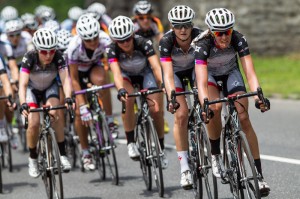The art of drafting: how to follow a wheel
 One of the skills it took me quite a long time to master when I started road cycling was following closely behind the wheel in front of me. I was not confident about my own ability and bike skills and so I sat back and watched from afar. It was only with the encouragement of others that I practiced and slowly built my confidence. I think generally men are quicker to master these types of skills, but women have just as much ability once we know how and have the confidence.
One of the skills it took me quite a long time to master when I started road cycling was following closely behind the wheel in front of me. I was not confident about my own ability and bike skills and so I sat back and watched from afar. It was only with the encouragement of others that I practiced and slowly built my confidence. I think generally men are quicker to master these types of skills, but women have just as much ability once we know how and have the confidence.
Drafting is an important skills that is well worth learning if you want to maximise your enjoyment of riding out on the road. It’s actually quite exhilarating to be whisked along in a group and to feel like you are part of a ‘team’.
The benefit
Being able to draft or closely follow another rider is one of the key differences between a beginner and a more skilled rider. As Joe McRae says in her article for Total Women’s Cycling, “The scientific principles are pretty basic. Sitting closely behind another rider, you are sheltered and no longer pushing against the wind, but are literally being ‘carried’ along by the air pocket created behind. This can save you between 20 and 40% of your energy expenditure, depending on how close you are, how fast you are riding how strong the wind is.”
Practice
But learning to feel relaxed and comfortable riding close to another rider can take a little time, but most of all it takes practice. It’s something that you can build up over time. You might have a small group of friends who you ride with and you can practice riding closer to one another, both side-by-side and following, and over time you can get closer and closer. You’ll be amazed the first time you experience the feeling of being ‘towed along’ by the people in front of you. I find it quite satisfying.
For me, I just built up over time and rode with a small group to start. As my confidence grew I found larger groups like those organised by my bike club, LACC. I deliberately chose the groups that I knew would be a pace I could maintain, or at least for a short period of time. In fact, when I first started riding in some groups I’d find shortcuts to take so that I could rejoin the group. I also got lots of advice from the more experienced riders within these groups. They were both kind, and also looking out for their own safety and that of the group when dishing out advice, but I was quite grateful.
Find someone you trust
When you start out, it’s best to ride on the wheel of someone who has superior bike skills so that you know they will be predictable and not do anything unexpected. They will also let you know if there’s an obstacle you both need to avoid up ahead. If you find yourself on the wheel of an erratic rider, don’t be afraid to change your position within the group by signalling and moving to the left or right to move further back.
Head up
It is also important to keep your head up when you are riding closely behind another rider. Don’t stare at the actual wheel but rather look through them at hip level so that you can see if there’s an issue ahead of you.
Don’t overlap wheels
Another important skill to master is to follow the line of the rider in front so you are not ‘overlapping’ their wheel. It’s alright to ride off-centre from them a little, but don’t let your front wheel overlap their back wheel and come up beside them because if they move across at all they’ll bump your front wheel with their rear wheel and send you packing.
Be consistent
When you are following closely behind someone you need to ride at the same speed as them and remain consistent because you are likely to have another rider on your wheel. If you have to brake for some reason then tell the rider behind what you are doing.
Leading another rider safely and smoothly also requires practice and is not that easy to do well. With someone riding closely behind, you have a responsibility to keep them safe too, which means no sudden braking, or change of direction that might cause them to touch your wheel. There’s no compliment higher for me than another rider telling me that they like riding on my wheel because I ride at a consistent pace.
